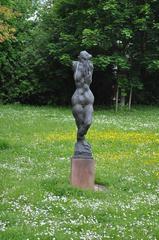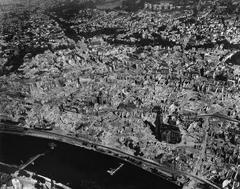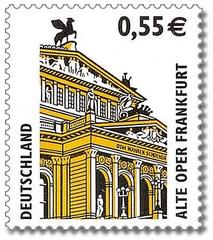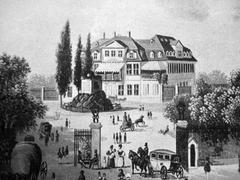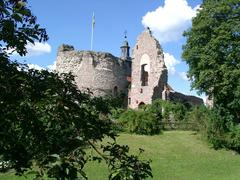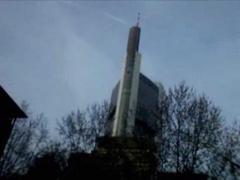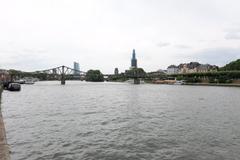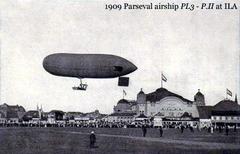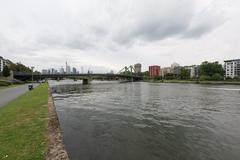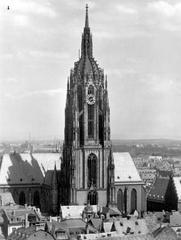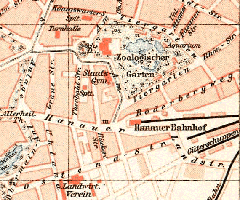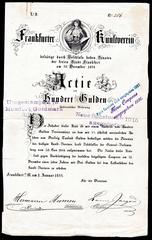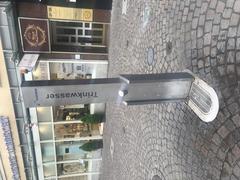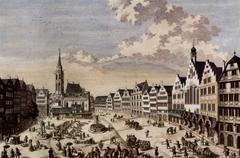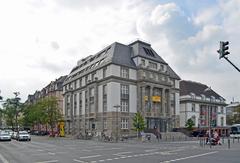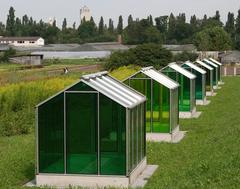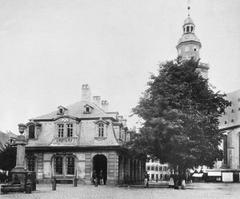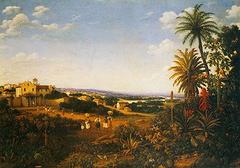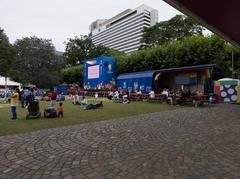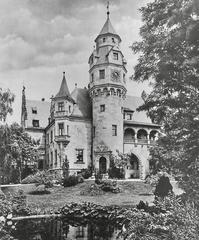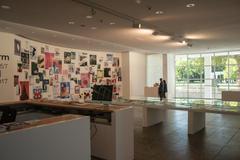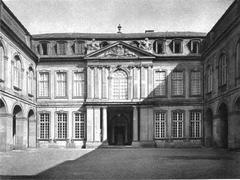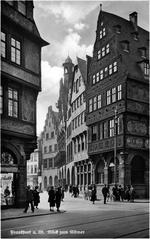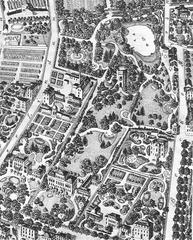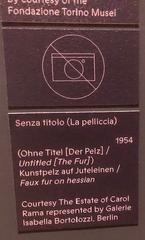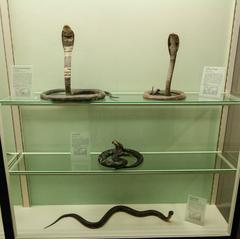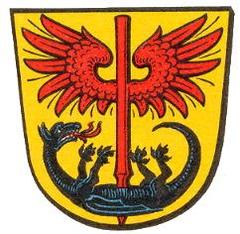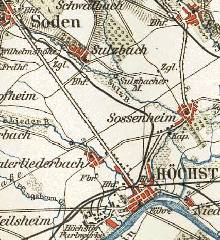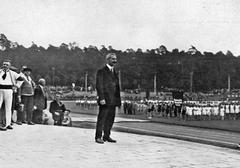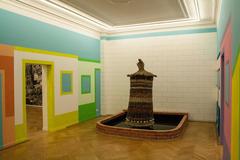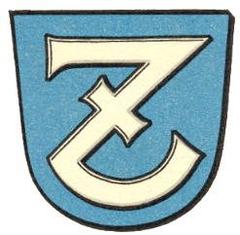Comprehensive Guide to Visiting Frankfurter Märchenbrunnen, Frankfurt am Main, Germany
Date: 01/08/2024
Introduction
Welcome to the comprehensive guide to visiting the Frankfurter Märchenbrunnen, an enchanting cultural landmark in Frankfurt am Main, Germany. This fairy tale fountain, also known as the Schauspielhausbrunnen, is a testament to the city’s rich history and artistic heritage. Commissioned by art patron Leo Gans and designed by the sculptor Friedrich Christoph Hausmann, this Art Nouveau masterpiece features a central figure modeled after a local laundress, Margarete Endres, and numerous other fairy tale characters (de.wikipedia.org). The fountain, situated in the picturesque Untermainanlage near the Frankfurt City Theaters, offers visitors a glimpse into early 20th-century artistry and is a symbol of Frankfurt’s resilience and cultural commitment (second.wiki). In this guide, you will find detailed information about the fountain’s historical context, visiting hours, ticket information, and nearby attractions, ensuring a well-rounded and memorable experience at one of Frankfurt’s most beloved sites.
Table of Contents
- Exploring the Frankfurter Märchenbrunnen
- Ultimate Guide to Visiting Frankfurter Märchenbrunnen: Hours, Tickets, and Tips
Exploring the Frankfurter Märchenbrunnen
History of Frankfurter Märchenbrunnen
Origins and Patronage
The Frankfurter Märchenbrunnen, also known as the Schauspielhausbrunnen, is an exquisite Art Nouveau fountain located in the Untermainanlage, adjacent to the Frankfurt City Theaters. The fountain’s construction was initiated and financed by the art patron Leo Gans, who was the head of the Cassella works in Fechenheim. Gans established an art fund at the turn of the century and allocated 150,000 marks (approximately 1.2 million euros in today’s purchasing power) for the project (de.wikipedia.org).
Artistic Creation
The sculptor Friedrich Christoph Hausmann was commissioned to design the fountain’s central figure, a nymph, from white Tyrolean marble. This nymph, popularly known as the “Mainweibchen,” was modeled after a young laundress named Margarete Endres, who worked in the household of the Jewish aristocratic family Carl and Arthur von Weinberg. Contrary to popular belief, Endres was not the daughter of a baker but a rubber mixing master from Lower Franconia. In 1906, at the age of 19, she posed as a model for Hausmann (second.wiki).
Visitor Experience
Visiting Hours and Ticket Information
The Frankfurter Märchenbrunnen is accessible to the public year-round. There are no entrance fees to visit the fountain, making it an ideal destination for budget-conscious travelers. However, visitors are encouraged to check the official website or local tourism boards for any special events or maintenance schedules that might affect visiting hours.
Travel Tips and Nearby Attractions
The Märchenbrunnen is situated in a small green belt alongside the Municipal Theatre near downtown’s Willy-Brandt-Platz. Visitors can easily reach the site via public transportation, with nearby U-Bahn and tram stations providing convenient access. In addition to the fountain, the surrounding area offers a variety of attractions, including the Frankfurt Opera, the Main Tower, and numerous dining options and accommodations.
Architectural and Cultural Significance
Destruction and Reconstruction
During World War II, the bronze figures adorning the Märchenbrunnen were melted down and were not replaced for a long time. It wasn’t until 2005/06 that these figures were reconstructed using photographs from the 1920s. The reconstruction was carried out by the North Korean Mansudae Overseas Projects at the Mansudae art studio. This decision, made in the run-up to the Frankfurt Book Fair 2004, aimed to encourage North Korea’s participation in the fair and support the reform process in the socialist country. The choice of contractor was also influenced by financial considerations (de.wikipedia.org).
Relocation and Modern Restoration
At one point, the Märchenbrunnen had to be temporarily removed to make way for the construction of an underground car park. However, since May 2006, the fountain has been fully reconstructed and stands proudly in the Untermainanlage, west of the Frankfurt Opera (second.wiki).
Cultural Significance
The Märchenbrunnen is not just a fountain but a symbol of Frankfurt’s rich cultural heritage. The water nymph at its center, inspired by a local figure, connects the city’s past with its present. The fountain’s Art Nouveau design reflects the artistic movements of the early 20th century, making it a significant landmark for both locals and tourists (frankfurt-rhein-main.de).
Key Historical Events
- 1910: Completion of the Märchenbrunnen, funded by Leo Gans.
- 1940s: Destruction of the bronze figures during World War II.
- 2005/06: Reconstruction of the bronze figures by North Korean artists.
- 2006: Full reconstruction and reinstallation in the Untermainanlage.
Architectural Details
The Märchenbrunnen is a prime example of Jugendstil (Art Nouveau) architecture. The use of white Tyrolean marble and the intricate design of the nymph figure highlight the artistic excellence of Friedrich Christoph Hausmann. The fountain’s design and its historical context provide a glimpse into the artistic and cultural milieu of early 20th-century Frankfurt (second.wiki).
Impact on Local Culture
The Märchenbrunnen has played a significant role in shaping the cultural landscape of Frankfurt. It stands as a testament to the city’s resilience and its commitment to preserving its artistic heritage. The fountain is not only a piece of art but also a symbol of the city’s historical journey, from its destruction during the war to its meticulous reconstruction in the 21st century (de.wikipedia.org).
FAQ Section
Q: What are the visiting hours for the Frankfurter Märchenbrunnen?
A: The Märchenbrunnen is accessible to the public year-round. It is recommended to check for any special events or maintenance schedules that might affect visiting hours.
Q: Is there an entrance fee to visit the Märchenbrunnen?
A: No, there is no entrance fee to visit the Märchenbrunnen.
Q: How can I reach the Märchenbrunnen?
A: The Märchenbrunnen is located near downtown Frankfurt’s Willy-Brandt-Platz and can be easily accessed via public transportation, including the U-Bahn and tram systems.
Q: Are there any guided tours available?
A: While there are no dedicated guided tours for the Märchenbrunnen, visitors can explore the fountain as part of broader city tours that cover Frankfurt’s historical and cultural landmarks.
Call to Action
To stay updated on the latest events and attractions in Frankfurt, follow us on social media and download our mobile app Audiala for more travel tips and guides.
Ultimate Guide to Visiting Frankfurter Märchenbrunnen: Hours, Tickets, and Tips
Introduction
Welcome to our ultimate guide on visiting Frankfurter Märchenbrunnen, a hidden gem in the heart of Frankfurt am Main, Germany. In this guide, we will provide you with essential tips and information to make the most of your visit, including the best times to visit, entry fees, guided tours, and nearby attractions. Whether you’re a history enthusiast, a photography lover, or simply looking to enjoy a peaceful day in the park, this enchanting fountain and its surroundings offer something for everyone.
Location and Accessibility
Frankfurter Märchenbrunnen is located in the scenic Volkspark Friedrichshain, easily accessible by public transportation. Visitors can take the U-Bahn (subway) to the nearest station, Konstablerwache. From there, it’s a short walk to the park. Alternatively, tram lines 12, 14, and 18 also stop nearby, making it convenient for those traveling from different parts of the city.
Best Time to Visit
The best time to visit Frankfurter Märchenbrunnen is during the spring and summer months, from April to September. During this period, the weather is generally pleasant, and the park is in full bloom, providing a picturesque backdrop for the fountain. Early mornings or late afternoons are ideal times to visit to avoid the midday heat and crowds.
Entry Fees and Operating Hours
There is no entry fee to visit Frankfurter Märchenbrunnen, as it is located in a public park. The park is open 24 hours a day, seven days a week, allowing visitors the flexibility to plan their visit at any time. For the best experience, it is recommended to visit during daylight hours when the fountain and surrounding sculptures are most visible.
Guided Tours
For those interested in a more in-depth understanding of the Märchenbrunnen and its historical significance, guided tours are available. These tours often include detailed explanations of the sculptures and their connections to the Brothers Grimm fairy tales. Information about guided tours can be obtained from the Frankfurt Tourist Information Center.
Cultural Significance and History
Frankfurter Märchenbrunnen, also known as the Fairy Tale Fountain, is a tribute to the Brothers Grimm and their famous fairy tales. The fountain features intricate sculptures representing characters from well-known stories such as Snow White, Cinderella, and Hansel and Gretel. It serves as a reminder of the rich cultural heritage and storytelling tradition of Germany.
Photography Tips
Frankfurter Märchenbrunnen is a popular spot for photography, thanks to its intricate sculptures and beautiful setting. Here are some tips for capturing the best photos:
- Golden Hour: Visit during the golden hour (shortly after sunrise or before sunset) for the best natural lighting.
- Angles: Experiment with different angles to capture the details of the sculptures. Low angles can make the statues appear more imposing.
- Background: Use the lush greenery of Volkspark Friedrichshain as a backdrop to add depth to your photos.
- Close-ups: Don’t forget to take close-up shots of the individual sculptures, especially the characters from the Brothers Grimm fairy tales.
Nearby Attractions
While visiting Frankfurter Märchenbrunnen, consider exploring other nearby attractions to make the most of your trip:
- Frankfurt Cathedral (Frankfurter Dom): A short walk from the park, this Gothic-style cathedral offers stunning architecture and panoramic views from its tower. More information can be found here.
- Goethe House (Goethes Wohnhaus): The birthplace of Johann Wolfgang von Goethe, one of Germany’s most famous writers, is located nearby. The house has been preserved to reflect the period in which Goethe lived.
- Museum Embankment (Museumsufer): A collection of museums along the Main River, offering a variety of exhibitions ranging from art to history. Details are available here.
Dining Options
There are several dining options near Frankfurter Märchenbrunnen, ranging from casual cafes to fine dining restaurants:
- Café Maingold: Located a short walk from the park, this café offers a cozy atmosphere and a variety of pastries, sandwiches, and coffee.
- Restaurant Klosterhof: For a more traditional German dining experience, this restaurant serves classic dishes such as schnitzel and bratwurst.
- MainNizza: Situated along the Main River, this restaurant offers a mix of Mediterranean and German cuisine with beautiful river views.
Safety Tips
While Frankfurt is generally a safe city, it’s always good to take some basic precautions:
- Personal Belongings: Keep an eye on your personal belongings, especially in crowded areas.
- Night Visits: If you plan to visit the park at night, go in a group and stay in well-lit areas.
- Emergency Numbers: Familiarize yourself with local emergency numbers. In Germany, the emergency number for police is 110, and for medical emergencies, it’s 112.
Special Events
Frankfurter Märchenbrunnen and the surrounding Volkspark Friedrichshain often host special events and festivals, especially during the summer months. Some notable events include:
- Main Festival: Held from August 2-5, 2024, this family-friendly festival features traditional rides, historical activities, and fireworks. More details can be found here.
- Museumsuferfest: Scheduled for August 23-25, 2024, this festival celebrates Frankfurt’s cultural diversity with art exhibitions, live music, and culinary delights. Information is available here.
Souvenirs and Shopping
For those looking to take home a piece of their visit, there are several souvenir shops and markets nearby:
- Frankfurt Christmas Market: If visiting during the holiday season, the Frankfurt Christmas Market offers a variety of traditional handicrafts and souvenirs. More information can be found here.
- Local Shops: There are numerous local shops around the park selling unique items such as handmade jewelry, local art, and traditional German products.
FAQ Section
Q: What are the visiting hours for Frankfurter Märchenbrunnen?
A: The park where Frankfurter Märchenbrunnen is located is open 24 hours a day, seven days a week. For the best experience, it is recommended to visit during daylight hours.
Q: Is there an entrance fee to visit Frankfurter Märchenbrunnen?
A: No, there are no entry fees as it is in a public park.
Q: How can I book a guided tour?
A: Information about guided tours can be obtained from the Frankfurt Tourist Information Center.
Conclusion
The Frankfurter Märchenbrunnen stands as a remarkable symbol of Frankfurt’s dedication to preserving its cultural and artistic heritage. From its inception in the early 20th century to its meticulous reconstruction after World War II, the fountain embodies the city’s resilience and appreciation for its historical landmarks. Visitors to the Märchenbrunnen can enjoy a serene environment, rich with historical significance and artistic beauty, all while being reminded of the timeless fairy tales that continue to inspire generations (frankfurt-rhein-main.de). Whether you are exploring the intricate sculptures of fairy tale characters, contemplating the fountain’s artistic details, or simply enjoying the nearby attractions, the Frankfurter Märchenbrunnen offers a unique and enchanting experience. For ongoing updates and travel tips, follow our social media channels and download our mobile app Audiala to enhance your visit.
References
- Frankfurter Märchenbrunnen, Wikipedia source - 2023
- Frankfurter Märchenbrunnen, second.wiki source - 2023
- Märchenbrunnen (Fairy Tale Fountain), Frankfurt Rhein Main source - 2023
- Märchenbrunnen, Nomads Travel Guide source - 2023
- Main Festival, Visit Frankfurt source - 2023
- Frankfurt am Main, Britannica source - 2023
- Major Events in Frankfurt Summer 2024, The Frankfurt Edit source - 2024
- 1-Day in Frankfurt Guide, My Germany Vacation source - 2024
